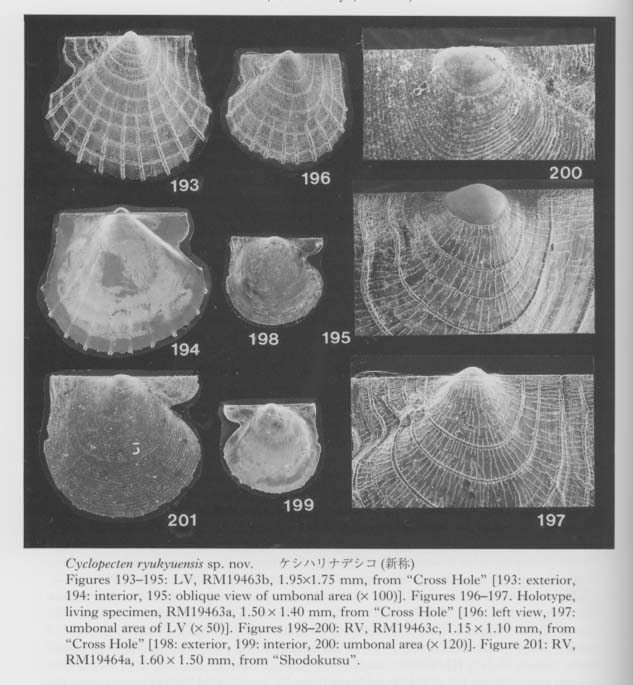Cyclopecten ryukyuensis sp. nov.
Figures 193-201

1992. Cyclopecten sp. A and B, Kase and Hayami, Jour, Moll. Studies, vol.58, p.448, listed.
Type and material.—Holotype: RM19463a, a living specimen, from the bottom sediments of "Cross Hole" of Irabu Islet, Miyako Islands, Paratypes: RM194S6 (dead) from "Devil's Palace", RM19457 (dead) from "Fool's Palace", RM19458 (dead) from "Witch's House", RM19459 (dead) from "Toriike", RM19460 (dead) from "Black Hole", RM19599 (dead) from "Coral Hole" of Shimoji Islet. RM19461 (dead) from "W-arch", RM19462 (dead) from "L-arch", RM19463 (living) from the type locality of Irabu Islet. RM19464 (dead) from "Shodokutsu", RM19570 (dead) from "Daidokutsu" of Ie Islet.
Diagnosis.—Small-sized, comparatively low and paedomorphic species of Cyclopecten, characterized by deep byssal notch, long dorsal margin, poorly defined posterior auricle, and coarsely cancellate ornaments in addition to persistent Camptonectes-striae in LV.
Description.—Shell small, rarely exceeding 2.5 mm in length, very thin, translucent, nearly acline, weakly convex, a little longer than high. Umbo located near midpoint of dorsal margin. Dorsal margin long, occupying nearly the whole shell length. Byssal notch deep. Posterior auricle large, rectangularly truncated but poorly defined from. disk. Disk of RV covered with dense commarginal lamellae and numerous fine rectangular interstitial threads representing regular arrangement of simple quadritic prismatic crystals of outer layer. Byssal auricle bears several weak radial ribs, while posterior auricle often has a strong radial rib and coarse commarginal lamellae. Disk and both auricles of LV marked with widely spaced and strong commarginal lamellae and several irregular radial ribs. Camptonectes-striae of LV persistent until later dissoconch. No internal ribs. Resilium pit spoon-shaped, projecting downward. Numerous denticles of provinculum persistent throughout growth. Pd I large, D-shaped, ranging 165-204 µm in maximum diameter; Pd II absent.
Remarks.—In a preliminary study (Kase and Hayami, 1992), we identified two unnamed species of Cyclopecten in the bottom sediments of "Shodokutsu"; a strong radial ribs occurs on the middle of the posterior auricle in one species and not in the other. However, the difference between the two forms is actually gradational and is regarded here as due to intrapopulational variation. The morphology of this species is somewhat similar to that of the juvenile stage of Parvamussium crypticum sp. nov. but is clearly distinguishable from it by fewer radial ribs, more persistent Camptonectes striae in LV (at similar size) and absence of internal ribs throughout growth.
The long dorsal margin, poorly defined posterior auricle and coarse cancellate ornaments at a glance constitute criteria for characterizing this species, but these features are shared by juvenile specimens of many species of Cyclopecten (and Parvamussium).
Distribution.—Common in many sublittoral caves of Ie, Shimoji and Irabu Islets, Ryukyu Islands. This species also occurs in "Balicasag Cave" off Panglao Islet of Bohol Island, the Philippines.
Genus Chlamydella Iredale, 1929
Chlamydella was proposed by Iredale (1929) for a diminutive, hyaline pectinacean species, Cyclopecten favns Hedley, 1902, from lower sublittoral substrata of eastern Australia. As originally described in detail, the type species seems to be well characterized by the pteriform shell and honeycomb-like shell microstructure of RV. Another Hedley's species, Cyclopecten obliquus, may be congeneric or even conspecific with the type species (Cotton and Godfrey, 1938). No additional species, so far as we are aware, was described under this generic name, but Cyclopecten hexagonalis Powell, 1958, has similar honeycomb structure, as clearly illustrated by Dell (1990). This genus also may include Pecten aviculoides Smith, 1885, from the sea off Prince Edward Island, Pecten (Pseudamusium) meleagrinus Thiele in Thiele and Jackel, 1931, from the sea around the Kerguélen Islands, and a few species of "Cyclopecten" (listed by Dell, 1990) from the Subantarctic seas. Detailed features of these species, however, are now difficult to recognize from their original descriptions.
Recently, we unexpectedly discovered numerous living specimens of two pteriform propeamussiids in the cave sediments of the Ryukyu Islands. One has strongly cancellate ornaments on the surface of LV, while the other shows nearly a smooth surface and much thinner test. The two species reveal characteristic honeycomb structure of RV (Figures 202, 216). They are brooding species, and their Pd I is unusually large and strange in shape for pectinaceans. Through the courtesy of the staff of the Australian Museum, we were able to examine the holotype (C13231) of Chlamydella favus (Hedley). Although the shell structure and other essential characters are similar to the cave species, the Pd I of C. favus is much smaller and normal in shape. We think that the discrepancy of Pd I indicates only different developmental strategy instead of generic or subgeneric difference.
As the result of our comparative study by SEM observations, it is concluded that Chlamydella should be taxonomically placed near Cyclopecten, as treated by Hertlein in Cox et al. (1969), but is distinguishable from Cyclopecten by the commarginally elongate hexagonal (honeycomb-like) simple calcitic prisms of the outer layer of RV as well as the pteriform outline of both valves with undifferentiated auricles (except the byssal auricle of RV). The outer layer of RV of Cyclopecten bistriatus (Dall, 1916), Cyclopecten nakaii Okutani, 1962, and Cyclopecten ryukyuensis sp. nov., for example, also consists of simple prismatic calcite, but the prisms are subquadrate (not hexagonal) and regularly arranged along the growth lamellae.
Cyclochlamys Finlay, 1927 [type-species: Pecten transennus Suter, 1913, from New Zealand] is generally regarded as synonymous with Cyclopecten (Dell, 1956; Hertlein in Cox et al., 1969; Dijkstra, 1991). The LV of the New Zealand species, as described by Dell (1956), exhibits remarkably cancellate ornaments and poorly defined auricles and is similar to that of one of the present cave species. Though the shell structure of C. transennus has not been described, there is a possibility that Chlamydella falls into a junior synonym of Cyclochlamys. The outline of RV of C. transenmis, however, is more pectiniform than and differs in other ways from that of the type and present species of Chlamydella.